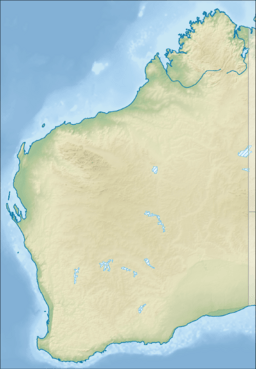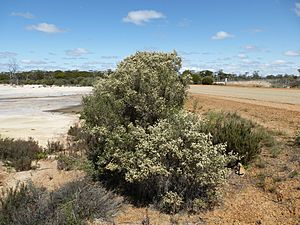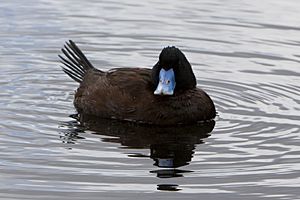Coyrecup Lake facts for kids
Quick facts for kids Coyrecup Lake |
|
|---|---|
| Location | Great Southern, Western Australia |
| Coordinates | 33°42′30″S 117°50′07″E / 33.70833°S 117.83528°E |
| Type | saline |
| Primary inflows | Groundwater and surface runoff |
| Catchment area | 194,165 ha (479,790 acres) |
| Basin countries | Australia |
| Surface area | 453 ha (1,120 acres) |
| Max. depth | 3 m (9.8 ft) |
| Water volume | 4,533,000 m3 (160,100,000 cu ft) (per metre of depth) |
Coyrecup Lake is a special salt lake in Western Australia. It is located about 25 kilometers (15 miles) east of the town of Katanning. The lake is also about 302 kilometers (188 miles) south-east of Perth.
Coyrecup Lake is an ephemeral lake. This means it doesn't always have water. It often dries up for several months during summer. The lake is found inside the Coyrecup Nature Reserve. It is part of the Blackwood River water system.
Contents
About Coyrecup Lake
Coyrecup Lake is shaped like an oval. It covers an area of about 453 hectares (1,120 acres). The lake sits on an old plateau made of very hard rocks. These rocks are called gneiss and granite. The area around the lake is a wide, flat floodplain.
The land around the lake has gentle hills. Most of the natural plants have been cleared. Now, the land is mostly used for growing crops like cereals. However, some native plants still grow there. These include a type of scrub with many unique species.
Water Flow and Depth
Water flows into the lake from two main places. One is a long watercourse about 20 kilometers (12 miles) long. It comes from the north-east. The other is Little Creek, which is about 15 kilometers (9 miles) long. It comes from the south.
When the lake is full, the water can be as deep as 3 meters (10 feet). But on average, it is about 1.7 meters (5.6 feet) deep in spring. The lake's catchment area is very large. It covers about 194,165 hectares (479,790 acres). This is the area of land where all the water drains into the lake.
History and Importance
In the early 1900s, people used Coyrecup Lake for boating. This shows it was a popular spot.
In 1980, something interesting happened. While the lake was dry, 44 small islands were built. These islands were placed in two groups. One group was north of where the water flows in. The other was to the south. These islands were made to be safe places for waterbirds to nest and rest.
Coyrecup Lake is also very important for wetlands. It is one of five sites in its region recognized as a DIWA wetland. DIWA stands for "A Directory of Important Wetlands in Australia." This means it's a nationally important wetland.
Plants of the Lake
Coyrecup Lake is part of a special plant system. This system is found in the South-west Botanical Province of Australia. The lake itself has many plants growing in the water. These include Ruppia polycarpa and a type of algae called Chara.
The plants around the edge of the lake are called littoral vegetation. This area has low shrubs. Many of these are samphire species. Samphire plants can grow well in salty soil. Some common samphire types here are Halosarcia pergranulata, Halosarcia lepidosperma, and Sarcocornia quinqueflora.
Around these shrubs, there are thicker areas of trees and bushes. These include Casuarina obesa, Melaleuca strobophylla, and Disphyma crassifolium. You can also find Melaleuca halmaturorum often in the lake basin. There are even some rare plant species found in the nature reserve. These include Dryandra porrecta and Blennospora phlegmatocarpa.
Animals of the Lake
Scientists have found many different types of tiny water animals in Coyrecup Lake. Over the past few years, 70 different kinds of aquatic invertebrates have been collected. Invertebrates are animals without backbones. Some of these animals like salty water, while others prefer less salty water. About half are macroinvertebrates, which are bigger invertebrates you can see. The other half are microinvertebrates, which are too small to see without a microscope.
Birdlife
Coyrecup Lake is a very important place for birds. It can support tens of thousands of birds at one time. A total of 41 different bird species have been seen in the lake area.
Some of the most common waterbirds include the Australian shelduck, black swan, grey teal, pink-eared duck, pacific black duck, and maned duck.
The lake is also home to some very important and endangered waterfowl. These include the freckled duck and the blue-billed duck. At least five different types of waterbirds use this area to breed and raise their young.




